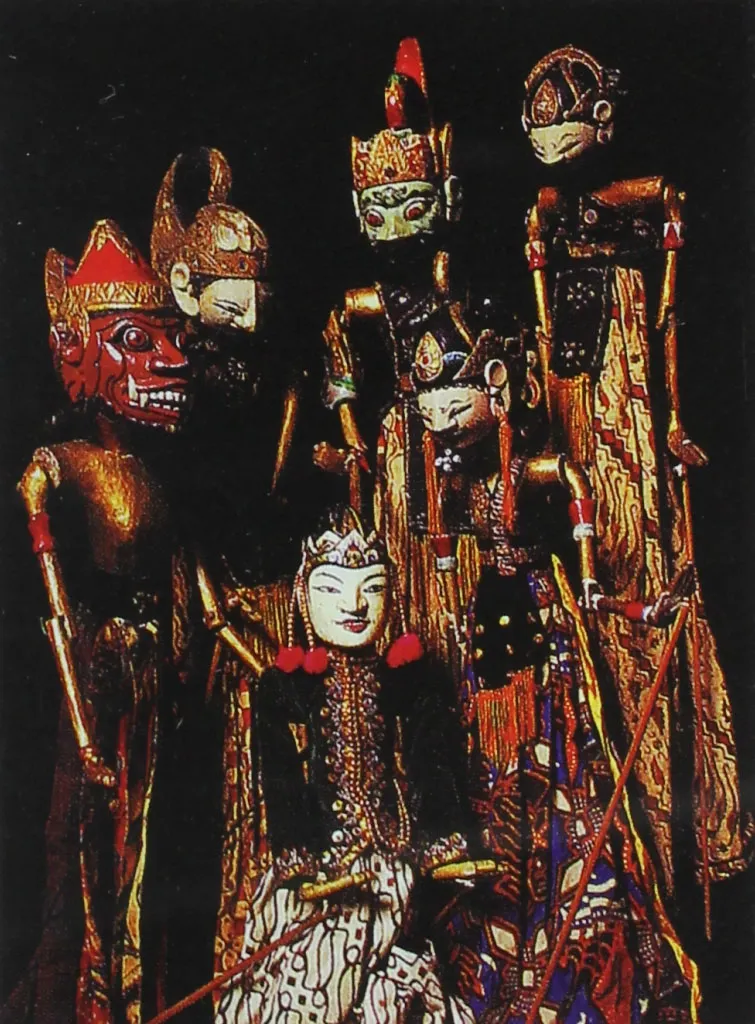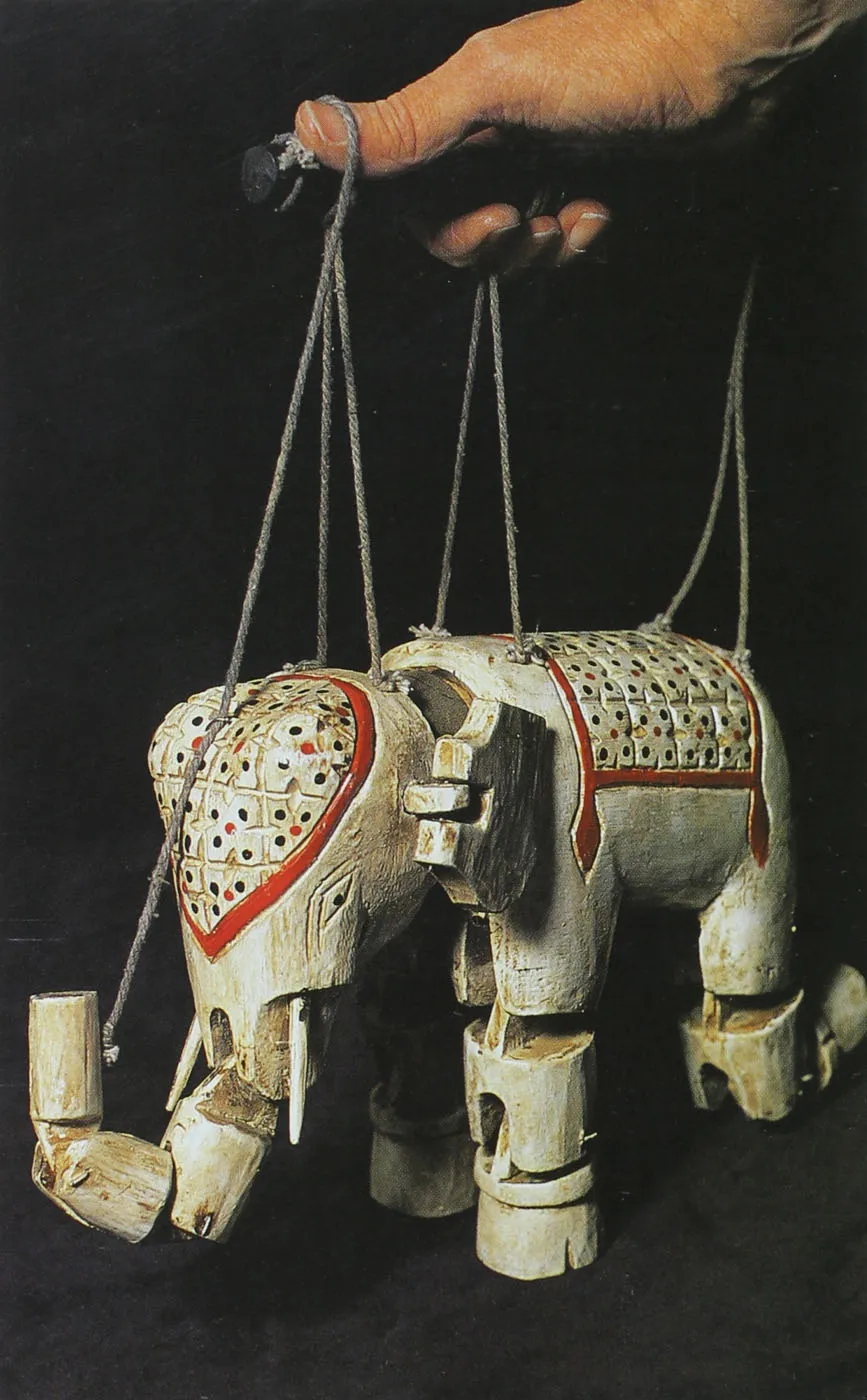
eBook - ePub
Puppets and Puppet Theatre
David Currell
This is a test
Buch teilen
- 176 Seiten
- English
- ePUB (handyfreundlich)
- Über iOS und Android verfügbar
eBook - ePub
Puppets and Puppet Theatre
David Currell
Angaben zum Buch
Buchvorschau
Inhaltsverzeichnis
Quellenangaben
Über dieses Buch
Puppets & Puppet Theatre is essential reading for everyone interested in making and performing with puppets. It concentrates on designing, making and performing with the main types of puppet, and is extensively illustrated in full colour throughout.Topics covered include: nature and heritage of puppet theatre; the anatomy of a puppet, its design and structure; materials and methods for sculpting, modelling and casting; step-by-step instructions for making glove, hand, rod and shadow puppets & marionettes; puppet control and manipulation; staging principles, stage and scenery design; principles of sound & lighting and finally, organisation of a show.
Häufig gestellte Fragen
Wie kann ich mein Abo kündigen?
Gehe einfach zum Kontobereich in den Einstellungen und klicke auf „Abo kündigen“ – ganz einfach. Nachdem du gekündigt hast, bleibt deine Mitgliedschaft für den verbleibenden Abozeitraum, den du bereits bezahlt hast, aktiv. Mehr Informationen hier.
(Wie) Kann ich Bücher herunterladen?
Derzeit stehen all unsere auf Mobilgeräte reagierenden ePub-Bücher zum Download über die App zur Verfügung. Die meisten unserer PDFs stehen ebenfalls zum Download bereit; wir arbeiten daran, auch die übrigen PDFs zum Download anzubieten, bei denen dies aktuell noch nicht möglich ist. Weitere Informationen hier.
Welcher Unterschied besteht bei den Preisen zwischen den Aboplänen?
Mit beiden Aboplänen erhältst du vollen Zugang zur Bibliothek und allen Funktionen von Perlego. Die einzigen Unterschiede bestehen im Preis und dem Abozeitraum: Mit dem Jahresabo sparst du auf 12 Monate gerechnet im Vergleich zum Monatsabo rund 30 %.
Was ist Perlego?
Wir sind ein Online-Abodienst für Lehrbücher, bei dem du für weniger als den Preis eines einzelnen Buches pro Monat Zugang zu einer ganzen Online-Bibliothek erhältst. Mit über 1 Million Büchern zu über 1.000 verschiedenen Themen haben wir bestimmt alles, was du brauchst! Weitere Informationen hier.
Unterstützt Perlego Text-zu-Sprache?
Achte auf das Symbol zum Vorlesen in deinem nächsten Buch, um zu sehen, ob du es dir auch anhören kannst. Bei diesem Tool wird dir Text laut vorgelesen, wobei der Text beim Vorlesen auch grafisch hervorgehoben wird. Du kannst das Vorlesen jederzeit anhalten, beschleunigen und verlangsamen. Weitere Informationen hier.
Ist Puppets and Puppet Theatre als Online-PDF/ePub verfügbar?
Ja, du hast Zugang zu Puppets and Puppet Theatre von David Currell im PDF- und/oder ePub-Format sowie zu anderen beliebten Büchern aus Media & Performing Arts & Performing Arts. Aus unserem Katalog stehen dir über 1 Million Bücher zur Verfügung.
Information
Thema
Performing Arts1 An Introduction to Puppet Theatre
PUPPET THEATRE HERITAGE
Puppetry and puppet theatre have a long and fascinating heritage. The origins of this visual and dramatic art are thought to lie mainly in the East, although exactly when or where it originated is not known. It may have been practised in India 4000 years ago: impersonation was forbidden by religious taboo and the leading player in Sanskrit plays is termed sutradhara (‘the holder of strings’), so it is likely that puppets existed before human actors.

Fig 1 Javanese wayang golek rod puppets
In China, marionettes were in use by the eighth century AD and shadow puppets date back well over 1000 years. The Burmese puppet theatre had a significant influence on the development of the human dance drama, and a dancer’s skill is still judged on his or her ability to re-create the movements of a marionette. And Chikamatsu Monzaemon (1653-1725), Japan’s finest dramatist, wrote not for human theatre, but for the Bunraku puppets (see Fig 24), which once overshadowed the Kabuki in popularity.

Fig 2 An Indian marionette from the Rajasthan region

Fig 3 A traditional carved Burmese marionette
In Europe, the puppet drama flourished in the early Mediterranean civilizations and under Roman rule. The Greeks may have used puppets as early as 800 BC, and puppet theatre was a common entertainment – probably with marionettes and glove puppets – in Greece and Rome by 400 BC, according to the writings of the time. In the Middle Ages, puppets were widely used to enact the scriptures until they were banned by the Council of Trent. Since the Renaissance, puppetry in Europe has continued as an unbroken tradition.
Sicilian puppets – knights one metre (three feet) high, wearing beaten armour and operated from above with rods (see Fig 32) – have performed the story of Orlando Furioso since the sixteenth century, but this type of puppet was, in fact, in use as long ago as Roman times. In Germany, puppets have performed The History of Doctor Faustus since 1587, and in France marionette operas became so popular that in 1720 the live opera attempted to have them restricted by law. The eighteenth-century French Ombres Chinoises shadow puppets were not only a fairground entertainment but were popular among artists and in the fashionable world.
In England, puppets were certainly known by the fourteenth century and, during the Civil War, when theatres were closed, puppet theatre enjoyed a period of unsurpassed popularity. By the early eighteenth century it was a fashionable entertainment for the wealthy, and in the late nineteenth century England’s marionette troupes, considered to be the best in the world, toured the globe with their elaborate productions.
The ubiquitous Mr Punch originated in Italy. A puppet version of Pulcinella, a buffoon in the Italian Commedia dell’ Arte, was carried throughout Europe by the wandering showmen and a similar character – including Petruschka (Russia), Pickle Herring, later Jan Klaasen (Holland), and Polichinelle (France) – became established in many countries. The French version was introduced to England in 1660 with the return of Charles II; it became Punchinello, soon shortened to Punch, and enjoyed such popularity that he began to be included in all manner of plays. By 1825, Punch was at the height of his popularity, and the story in which he played had taken on its standard basic form.
In the nineteenth century the puppet show was taken to America by emigrants from many European countries, and their various national traditions laid the foundations for the great variety of styles found there today.
Eastern Europe had early traditions of travelling puppet-showmen but, with a few exceptions, puppetry did not develop significantly there until the twentieth century. However, it then progressed at an impressive rate.
The twentieth century has brought new materials and techniques to puppet theatre, and has seen a revival of interest in the art through television and film, as well as a renewed emphasis on the quality of live performances. Official recognition of puppetry as a performance art has now been achieved.
THE NATURE OF THE PUPPET
The survival of puppet theatre over some 4000 years owes a great deal to man’s fascination with the inanimate object animated in a dramatic manner, and to the very special way in which puppet theatre involves its audience. Through the merest hint or suggestion in a movement – perhaps just a tilt of the head – the spectator is invited to invest the puppet with emotion and movement, and to see it ‘breathe’.
A puppet is not an actor, and puppet theatre is not human theatre in miniature. In many ways, puppet theatre has more in common with dance and mime than with acting. Puppet theatre depends more upon action and less upon the spoken word than the actor does; generally, it cannot handle complex soul-searching, and it is denied many of the aspects of non-verbal communication that are available to the actor. But the puppet, still or moving, can be just as powerful as the actor.
The actor represents but the puppet is. The puppet brings to the performance just what you want and no more; it has no identity outside its performance, and brings no other associations on to the stage. The puppet is free from many human physical limitations and can speak the unspeakable, and deal with taboos. The power and potential of the puppet has attracted artists such as Molière, Cocteau, Klee, Shaw, Mozart, Gordon Craig, Goethe and Lorca who have all taken a serious interest in this art – one of the most liberating forms of theatre.

Fig 4 Pulcinella, a large marionette, as he first appeared in England, re-created for television by Mary Edwards. The head is carved in jelutong wood
TYPES OF PUPPET AND STAGING
Most types of puppet in use today fall into four broad categories – hand or glove puppets, rod puppets, marionettes and shadow puppets – but there is a variety of combinations. Among these are glove-rod, hand-rod, rod-hand and rod-marionette puppets, detailed in Chapter 2. There is also a wide range of other related techniques, from masks to finger puppets, from the toy theatre to animated puppet film.
The glove puppet is used like a glove on the operator’s hand; the term ‘hand puppet’ is sometimes used synonymously but here it describes figures where the whole hand is inserted into the puppet’s head. Glove puppets are quite simple in structure but hand puppets often have a costumed human hand, or arms and hands operated by rods. These puppets, although limited in gesture to the movement of one’s hand, are ideal for quick, robust action and can be most expressive. The live hand inside the puppet gives it a unique flexibility of physique.
The rod puppet is held and moved by rods, usually from below but sometimes from above; those in the Japanese Bunraku style require two or three operators, who hold the puppet in front of them. Rod puppets vary in complexity, ranging from a simple shape supported on a single stick to a fully articulated figure. They offer potential for creativity in design and presentation, and their range of swift and subtle movements enables them to deliver anything from sketches to large dramatic pieces.
The marionette is a puppet on strings, suspended from a control held by the puppeteer. It is versatile and can be simple or complex in both construction and control. Performances can be graceful and charming, and fast and forceful action is generally avoided. For manipulation, the experienced puppeteer draws upon the marionette’s natural movements to great advantage.
Shadow puppets are normally flat cut-out figures held against a translucent, illuminated screen. The term is also used loosely to describe fullcolour, translucent figures operated in the same manner. Shadow puppets are ideally suited to the illustration of a narrated story, but they can also handle direct dialogue and vigorous knockabout action.
Increasingly, puppeteers are exploring the use of space instead of restricting themselves to the confines of the conventional booth or stage. However, glove and rod puppets are usually presented from within a booth. The traditional covered booth is still used for ‘Punch and Judy’, but an open booth without a proscenium has become popular for other shows; it affords far greater scope for performance, and a wider viewing angle.
Marionette variety acts are frequently presented on an open stage with the puppeteer in view. The large marionette stage with a proscenium to hide the operators tends to be used for plays in more permanent situations: size, portability and setting-up time are factors that have influenced the trend towards open-stage performances. Although shad...